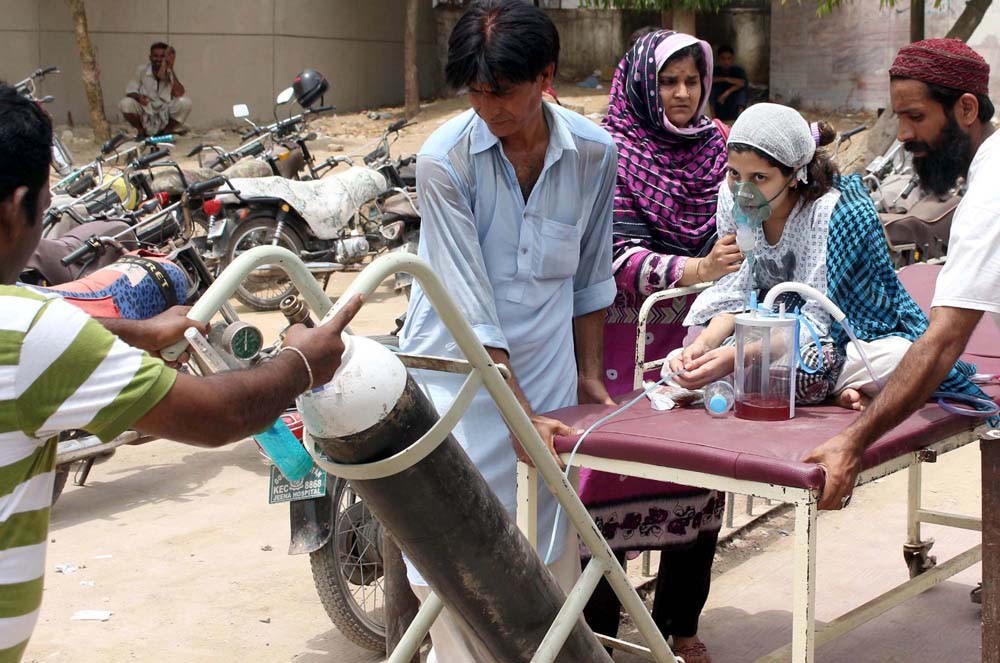
In the wake of the heatwave of Karachi, what’s amazing is the criminal ignorance of the city’s administration that was not only unprepared for a disaster of this scale but simply clueless as to how to respond

It all started on first Ramzan when an Edhi Centre shift in-charge noticed that the number of dead bodies coming to the mortuary tripled in a day.
"We issued a statement. I was a little scared when I started getting calls from the media and even government departments," says Mohammed Bilal, the shift in-charge. "We checked and rechecked the register to verify the numbers. Yes, it was going through the roof. The bodies kept coming."
Bilal did not know that what he witnessed firsthand was the result of the worst heatwave to hit Karachi in decades and that in the next three days the death toll would cross the 1000 mark. A calamity had struck.
But what amazing is the criminal ignorance of Karachi’s administration - made up of department under Sindh government and civic authorities - who were not only unprepared for a disaster of this scale but simply clueless as to how to respond to such a crisis. "To be honest, we never expected such an eventuality. The death toll was simply unimaginable," concedes commissioner Karachi Shoaib Siddqiui.
He also admitted that the authorties did not learn much from the same sort of heatwave that hit India, including urban hub like Mumbai, in the past month where several hundred people died. "The problem with Karachi is that several factors came along together to wreak this havoc."
Victims of heatstroke inundated hospitals across the city. Only the Jinnah Postgraduate Medical Centre (JMPC) dealt with over 200 bodies. Most of the victims arrived unconscious and later expired during treatment, claimed doctors.
Though no concrete figures can be ascertained, but doctors at JMPC say that most of the victims were between the ages of 40 to 60 and were associated with outdoor professions like fruit vendors, labourers and taxi drivers.
Experts believe that the astonishing death toll and the resulting helplessness of the government stem from the way Karachi, the city of more than 20 million people, is expanding -- with no bound in sight.
Read also: The read tragedy in Karachi
"It is in moments like this the authorities should pause and take a look at the pace at which Karachi is growing," says Zahid Farooq, an urban planner and a director at the Urban Resource Centre.
Farooq adds that half of Karachi was bereft of basic amenities like water and electricity, while there is no check in the number of high-rise buildings being constructed in the city. On the other hand, the absence of an efficient public transport is polluting the air as hundreds of motorbikes are added to Karachi’s roads every day. All of these issues have coalesced to make a disaster of this magnitude.
"Such factors come together to play a role when you have no planning and all of a sudden 1000 people lose their lives. That’s how crude lack of infrastructural planning resulting in urban pressures can be."
Since the last several weeks, the city was plagued by what seemed an unsolvable water crisis that kept the Pakistan People’s Party (PPP) and the main opposition Muttahida Quami Movement (MQM) squabbling in the parliament and the people protesting on the streets.
On the day the calamity struck, as Karachi’s temperature soared to 44.8 celcius, massive power outages took place in most areas of the city, further making the lives of people miserable as they began fasting on the first day of Ramzan.
Families of the victims say that lack of water and electricity in such scorching heat is to be blamed for the deaths. Farida Begum lost her 75-year-old father on the second day of the heatwave. "He was sitting in the living room. There was no electricity. My brother went out to fetch some ice for iftar, and in the meanwhile, our father expired."
Another forty-year-old patient Mohammad Muztafeez also complained of water shortages and power outage, saying it was unbearable. A resident of Korangi town, he was admitted at the JMPC. He was fasting and fainted while returning home from a nearby shop.
Doctors at the JMPC say that many of the families initially arrived at the emergency ward believing that the patients had a heart attack. "People did not know how to provide first aid treatment to a heatstroke victim, which also contributed to the deaths," says Dr Erum Arfeen, who claimed to have treated 54 patients.
Some observers, however, claim the political crisis ensued in the province after the Rangers accused the leaders of the PPP and the MQM of massive corruptions. Soon afterwards, the paramilitary force’s raid on Sindh Building Control Authority and the subsequent reports about barring several top political leaders and senior bureaucrats in Sindh from leaving the country also surfaced. All of this, they say, kept the politicians and bureaucrats too busy since the past two weeks to substantially react to the heatwave crisis.